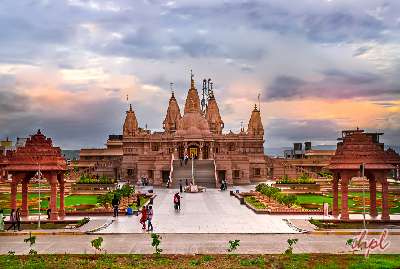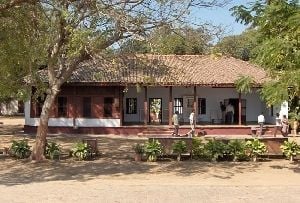Situated near the Chenab River, about 120 km to the north of Lahore, Gujarat is a coastal state lying on the west coast of India. Blessed with the longest coastline (1290 km) in the country, Gujarat is a serene and pristine land where the azure seas meet sparkling sands. We, at Indianholiday, are providing you a detailed guide on Climate in Gujarat.
Gujarat is positioned between 20° 6′ N to 24° 42′ N latitude and 68° 10′ E to 74° 28′ E longitude. The westernmost state in India, Gujarat is bordered by Pakistan and Rajasthan state in the north east, Madhya Pradesh in the east, and Maharashtra and the Union Territories of Daman, Diu, Dadra and Nagar Haveli in the south.
The state is bounded by the Arabian Sea in the west and the south west.The climate in Gujarat is moist in the southern areas while dry in the northern region. The Tropic of Cancer passes through the northern border of Gujarat, resulting in an intensely hot or cold climate in Gujarat. But the Arabian Sea bordering the state and the Gulf of Cambay in the west and the wooded hills in the east reduce the climatic extremes and make the climate more pleasant and salubrious.
In Gujarat, a year can be roughly divided into the winter season (November to February), summer season (March to May), southwest monsoon season (June to September), and the intervening month of October.
Explore 11 Days Gujarat Tour Package with Sasan Gir
The land relief in Gujarat is low in most parts of the state, resulting in a great diversity in the climate of Gujarat India. Gujarat experiences mild, pleasant and dry winters, with average daytime temperatures ranging around 83 °F(29 °C) and night temperatures around 53 °F(12 °C). The summers are very hot and dry, with day temperatures rising up to around 105 °F(41 °C) and night temperatures dropping to 85 °F(29 °C).
Gujarat experiences an average rainfall of around 33 to152cms. The southern parts of the state receive average rainfall hovering between 76 and 152 cms, the Dangs district having the highest average of around 190 cms. In the northern parts of Gujarat, average rainfall ranges between 51 to 102 cms.
The southern highlands of Saurashtra and the Gulf of Cambay receives about 63 cms of rainfall, while other parts of Saurashtra receive rainfall less than 63 cms. The semi-desert Kutch area in Gujarat experiences a very low average rainfall. Some areas in Ahmedabad, Mehsana, Banaskantha, Panchmahals, Surendranagar, Jamnagar and Kutch districts face chronic shortage of water because of inadequate rains. These factors account for the wide diversity in the climate of Gujarat.
Ahmedabad – the busiest city in Gujarat experiences a dry climate in the summer and winter months. Through the months of March to June, the weather remains hot. From November to February, the climate gets extremely dry, and the cold northerly winds results in a mild chill in January. The southwest monsoon ensures that the city experiences a humid climate from mid-June to mid-September.
Gujarat Temperature
The land relief in Gujarat is low in most parts of the state, resulting in a great diversity in the climate of Gujarat, India. Gujarat experiences mild, pleasant, and dry winters, with average daytime temperatures ranging around 83 °F(29 °C) and night temperatures around 53 °F(12 °C). The summers are sweltering and dry, with day temperatures rising to around 105 °F(41 °C) and night temperatures dropping to 85 °F(29 °C).
Rainfall in Gujarat
Gujarat experiences an average rainfall of around 33 to 152 cm. The southern parts of the state receive average rainfall hovering between 76 and 152 cm, with the Dangs district having the highest average of around 190 cm. In northern Gujarat, average rainfall ranges between 51 to 102 cm. The southern highlands of Saurashtra and the Gulf of Cambay receive about 63 cm of rainfall, while other parts of Saurashtra receive less than 63 cm. The semi-desert Kutch area in Gujarat experiences a deficient average rainfall. Some areas in Ahmedabad, Mehsana, Banaskantha, Panchmahals, Surendranagar, Jamnagar, and Kutch districts face a chronic water shortage because of inadequate rains. These factors of Gujarat rainfall data account for the vast diversity in the climate of Gujarat.
Browse through our Gujarat Tour Packages from Bangalore, Dwarka Tour Packages from Mumbai
Seasonal Patterns of Gujarat
In Gujarat, a year can be roughly divided into the winter season (November to February), summer season (March to May), southwest monsoon season (June to September), and the intervening month of October.
Regional Climate Condition of Gujarat
North Region of Gujarat: This region experiences dry climate conditions with low rainfall and dry winds. North region cities of this state are Gandhinagar, Patan, Himatnagar, and Mehsana
Central Region of Gujarat: This region is known for its semi-dry climate conditions and also receives rainfall towards the south. The towns that cover this region are Vadodara, Ahmedabad, Anand, and Bhavnagar.
South Region of Gujarat: This region is one of the most charming and filled with greenery. You can expect a humid subtropical climate with heavy monsoon rainfall. Cities in the southern areas are Surat, Navsari, Daman, and Silvassa.
Coastal Region of Gujarat: This area of the state is locked with the Arabian Sea and experiences milder temperatures with high humidity. The destinations you can cover in this region are Porbandar, Dwarka, Somnath, and Diu.
The average temperature in Gujarat is around 30°C, and this state experiences significant variations in weather conditions in its different regions. You can plan your tour to Gujarat with us as per your choices and traveling preferences.
Check out Gujarat Tour Packages, Ahmedabad Tour Packages, Bhuj Tour Packages, Dasada Tour Packages, Vadodara Tour Packages, Junagadh Tour Packages, Somnath Tour Packages, Dwarka Tour Packages












